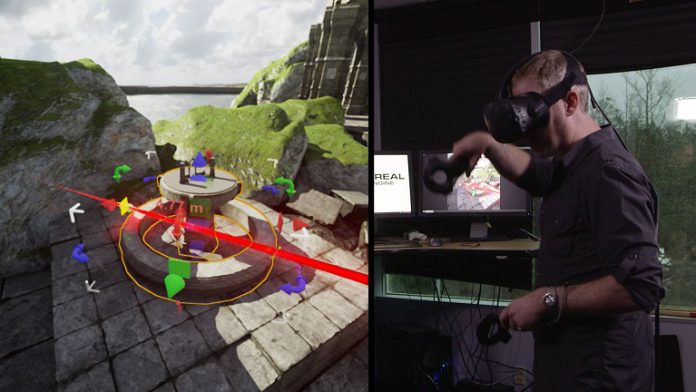Epic Games is first out of the gate with an in-engine virtual reality (VR) development suite, simply known as VR Editor, for their hugely popular Unreal Engine 4 platform. While both Unity Technologies and Crytek have announced similar plans, Epic Games’ software is available to download now, allowing all Unreal Engine 4 developers to begin designing the visual identity of videogame projects in VR immediately.
VRFocus‘ experience with the Unreal Engine 4 VR Editor has been limited to sample installations thus far, yet it’s still been available for a deeper dive than either of Epic Games’ competitor’s efforts. The first preview of the VR Editor came last month – a simple showcase of a small stone area featuring a scaleable robot – while at last week’s Game Developers Conference (GDC), San Francisco, a new template featuring an Old West theme was available for hands-on analysis.
This new template featured buildings, signposts, water towers and other environment dressing that was available to manipulate by way of size, orientation and positioning using the motion-tracking capabilities of the HTC Vive controllers. Duplicating these items or adding additional objects via the VR Editor’s asset menu is a very simple process, and in order to prevent the user from having to adjust their viewpoint for every single addition a simple ‘snap to ground’ menu option will line-up the positioning at point 0.0 based on the user’s chosen drop point. It’s a simple and intuitive process, but that’s not the most impressive part of the Unreal Engine 4 VR Editor.
Navigation of the world the user is creating is crucial. No designer wants to spend two hours constructing the perfect arrangement of materials in VR to then have to take off the head-mounted display (HMD) and wait for build or export times to complete. VR Editor allows the user to scale their viewpoint, moving from up to 50x straight down to a 1:1 ratio, giving the user the option to traverse the world just as the player would without any delay. While zoomed-out the user can navigate the world in a number of ways – pulling and rotating, leaping or teleporting using appropriate inputs and gestures – but when at the player level the greatest opportunity available is to move as the player would; in the example VRFocus was shown, this would be to use the HTC Vive’s roomscale technology.

Other aspects of the Unreal Engine 4 VR Editor that deserve acknowledgement include the real-time lighting editing, texture mapping and physics application, but these elements will be immediately obvious in their usage to any designer jumping into the suite for the first time. Less obvious is the implementation of Unreal Engine 4’s Blueprints system. Though far from fully fleshed out, the VR Editor allows designers to open a single Blueprint and adjust its properties from within. Further plans involve the full inclusion of dynamic editing to Blueprint strings, allowing physicalised objects to enact or react upon player or AI input. This, arguably, could lead to developers being able to create not just visual design in VR, but entire game loops and win/lose scenarios.
Though still very much in its infancy, the future potential of Unreal Engine 4’s VR Editor is phenomenal. At this point Epic Games are choosing not to suggest there’s anything more to the suite than the ability to design the visual layout of in-game areas, but it doesn’t take 20 years of development experience to understand that there’s more going on behind-the-scenes than a press statement and initial release version would suggest. VR Editor has given Unreal Engine 4 the opportunity to revolutionise and democratise videogame development in an even more significant way than the Blueprints system has, and should it reach it’s full potential there’s not doubt that in five years from now VR Editor software will become the de facto standard for videogame design, whether it be in the creation of end user VR software or not.















